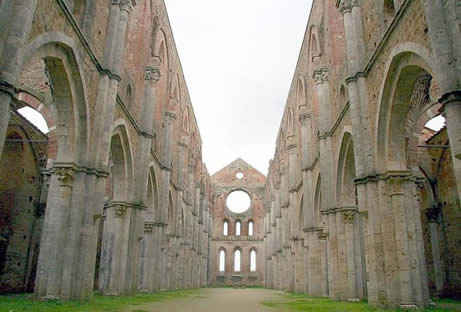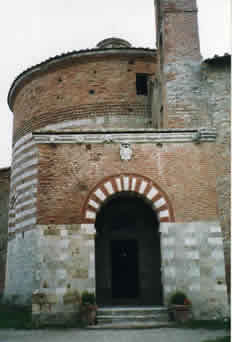INDEX
1. SIENA - MUSEUMS AND PALAZZI
3. PLACES WITHIN HALF AN HOUR OF BARONTOLI
5.HISTORICAL CHRONOLOGY
7. SAINTS IN ART
PLACES FURTHER AFIELD
SAN GALGANO
A romantic ruined abbey and a chapel with a sword in a stone, well worth a visit.
Open 0800-1200 and 1400 to sunset. About 30 kilometres along the Roccastrada road. Go straight through Rosia and on until you begin to see yellow signs to San Galgano. Visit both the chapel on the hill and the ruined monastery church which lies below it, about half a kilometre away. A vast new paying car-park has just been opened, but most people still park for free in front of the church. Only the disabled are supposed to drive up to the chapel on the hill. There are a couple of snackeries in the grounds.
The legend of San Galgano
San Galgano was a rich, aristocratic young man from nearby Chiusdino, born in 1148. Overcome with spiritual longings, he deserted the gay and frivolous life that he was expected to lead, albeit with a few battles thrown in for exercise. He built himself a round wooden hut on top of a small hill called Montesiepe, and became a hermit. To demonstrate to his mother and sister his resolution to shun henceforth frivolity and military activity, he plunged his sword into a cleft in a rock which had appeared in the middle of his hut. There it remained stuck until a very few years ago when some youths from a neighbouring village dared each other to remove the sword and managed to break off the hilt. It has now been cemented back in and a glass case constructed around it. The cement makes the whole thing look bogus, but the experts say that it definitely is a twelfth century sword.
The chapel
San Galgano died in his thirties, but he had already become famous for his holiness. Very shortly after his death, in 1182-5, a circular chapel was built on the site of his hut. This remains, together with the sword. A tiny baptistery opens out of it (ask the woman in the shop to open it if it is closed), covered in good but rather damaged frescoes by the fourteenth century artist Ambrogio Lorenzetti (who did the frescoes of Good and Bad Government in the Palazzo Pubblico in Siena). |
Photo by Giorces 2006 |
On the far wall of the little baptistery, the Virgin and Child sit in majesty surrounded by saints and angels. At some point Lorenzetti changed his mind about the position of the Virgin’s left hand, and a recent restoration has resulted in a three-handed figure, with both the old and the new positions being revealed. At the Virgin’s feet, Eve rather curiously sprawls, a goatskin over her shoulder with a serpent emerging from it, and a fig in her hand. The symbolism is far from clear, but an inscription on a scroll contrasts Eve, the cause of death, with Mary, mother of God, the cause of Life. To the right of Eve, the figure offering a heart to the Virgin is St Gertrude; and San Galgano is offering something in a straw basket. At the bottom of the fresco there is an Annunciation, where again restoration has revealed changes. Originally, the painter gave the Virgin a rather horrified expression; but this was felt to be inappropriate, and she was repainted with her present serene face.
On the left wall, San Galgano appears in the fresco, carrying a diminutive slice of rock with the sword sticking in it. He is offering the sword to Michael the Archangel as a sign of the consecration of Montesiepe as a holy place, and Michael invites him with a gesture of his arm to regard the Virgin. The two Bishops of Volterra who were responsible for the chapel hover behind the saint. Below, there is a rather fanciful representation of the Castel St Angelo in Rome with an angel on the roof putting a sword away as a sign of forgiveness. On the opposite wall, a large company of saints and angels is walking towards the Virgin.
In a little room at the entrance to the chapel, honeys and strange liqueurs and obscure tisanes with allegedly curative properties are sold. The "millefiori" honey is good.
The abbey church

Photo by Thudifushi 2008 via Wikimedia
Later, in 1218, a Cistercian abbey was built below Montesiepe, one of the largest in Italy, modelled on the great Cistercian foundations in Burgundy; indeed in style it is far closer to severe French (or English) Gothic than to the lacier Italian version. St Bernard, who founded the Cistercian order, laid down precise rules on the design of the buildings of his abbeys, with refectory, dormitory and chapter-house all in their allotted places, and these rules have been closely followed. In its hey-day, the monastery was the richest, largest and most powerful in the region, owning all the land around and operating like a little city. Cistercian monks did not stay in their monastery, and monks from San Galgano served as notaries, treasurers, doctors and architects in the Sienese Republic. They also worked the nearby mines. In the fourteenth century, however, the monastery was sacked by the English mercenary captain, Sir John Hawkwood of the White Company, who was employed by both Florence and Pisa at different times to fight their battles. The Black Death followed hard on Hawkwood’s heels, and the monastery never recovered. It went into a long decline; by 1550, there were only five monks left, and 50 years later only one monk in ragged clothes remained. Finally, the monastery became a farm and the abbey was plundered for its stone. Now all that remains are the great walls and windows of the abbey church, romantically roofless but still inspiring, together with parts of the monastery and a tiny bit of cloister.
1980s; revised 2005.
